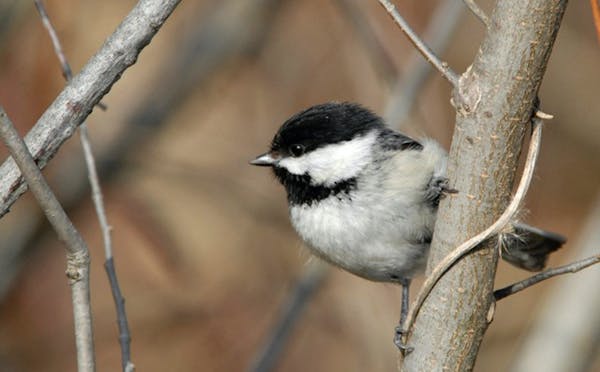A black-capped chickadee by any other name is a Poecile atricapillus.
That's the bird's scientific name, the reference used worldwide to avoid the confusion a list of local names could offer.
For instance, an Idaho natural history website lists these names also used for the same bird: Appalachian chickadee, black-capped titmouse, black-capped tit, Oregon chickadee, Yukon chickadee, common chickadee, long-tailed chickadee, and western titmouse.
Hey, one might say, which bird are we talking about?
The scientific name is used almost exclusively in scholarly publications, but can be found in your ID guides, too.
Online you can find more than one translation of the Latin Poecile atricapillus to English. The site 10,000 Things of the Pacific Northwest tells us that, "Poecile comes from a Greek word meaning 'many colored.' With a slight suffix change it also meant 'a small bird.' The species epithet atricapillus means 'black head hair.'" Thus, the black-capped chickadee.
North America also has these chickadee species: Carolina (Poecile carolinensis), mountain (Poecile gambeli), gray-headed (Poecile cinctus), boreal (Poecile hudsonicus), Mexican (Poecile sclateri), and chestnut-backed (Poecile rufescens).
There can be several reasons behind the Latin or Latinized name given to a bird. Philip Sclater was a British zoologist for whom several birds were named. Carolinensis designates a range including North and South Carolina. Dr. William Gambel was an important 19th-century ornithologist in California. Hudsonicus refers to northern portions of the U.S. and Canada. Rufescens is a red tinge.
Minnesota's second chickadee
The boreal chickadee is on the southern edge of its range in northern and mostly northeastern Minnesota. You can search for the boreal species without success; it is not common. It's easier to find, however, than the gray-headed chickadee, formerly known as the Siberian tit.
The only way to find that one is by taking a raft down a river in the Arctic National Wildlife Refuge in northern Alaska. A friend of mine did that.
He told a story of a long hike to a known nest involving a wide rocky river, crossing it knee-deep in fast-moving icy water while carrying all of his gear, sleeping bag and spotting scope. He saw the bird, though, and stayed dry. He was a serious and determined birder.
Scientific breakdown
Scientific names come from a system created by a Swedish scientist, Carl von Linné (1707-1778). He is better and most appropriately known by the Latin form of his name, Linnaeus.
He was a botanist, physician, and zoologist who described the formal system for naming organisms. With some modification, his original system is used today around the world.
The system has eight classifications, dividing into ever smaller parts. This is how it works for the chickadee.
Chickadees belong to the kingdom called Animalia (animals).
Then the phylum, Chordata (animals with a flexible spine).
Next, class: Aves (birds).
Then, order: Passeriformes (songbirds).
To genus (common characteristics).
To species (capable of interbreeding).
Finally, in this case, to subspecies, our particular black-capped chickadee.
Who makes naming decisions? Linnaeus published what he called the law of priority. That means that the first published name of a genus or species takes precedence.
If you are the first to publish you get to choose the two-part scientific name. The first word is a noun designating group, no leeway here. The second part of the name usually is an adjective describing physical characteristics, as in the case of our chickadee, but can be derived from several sources.
One of my favorite Latin names is for the Pacific-slope Flycatcher, Empidonax difficilis, named because it is particularly difficult to identify.
Google often will explain the background of bird names. It's a birding adventure fit for a cold day soon to be on its way.
Lifelong birder Jim Williams can be reached at woodduck38@gmail.com.

What we lose when chain drugstores replace family-owned independents
![George Floyd's daughter Gianna Floyd, 6, looks to her mother Roxie Washington during a press conference at Minneapolis City Hall. ] LEILA NAVIDI •](https://arc.stimg.co/startribunemedia/WSDMNXVK3VZJDLDP3BTMCSMXNU.jpg?h=91&w=145&fit=crop&bg=999&crop=faces)
Medcalf: Hateful comments made after recent column on George Floyd's daughter left me discouraged

John Cusack dishes on 'High Fidelity' at Minneapolis screening

For 'Legally Blonde' star, 'being underestimated is her secret superpower'

